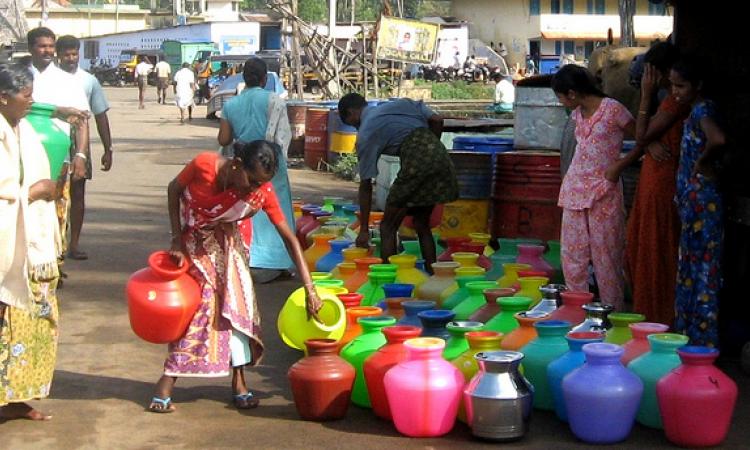
Water is more useful in terms of survival than diamonds. So why then does the latter, which is mostly for ornamental purposes, command a higher price in the market? This contradiction is termed the diamond-water paradox or the paradox of value.
Adam Smith in the 1700s had explained the paradox of value through economic terms -- scarcity and marginal utility. When he died in 1790, water wasn't scarce. Fourteen years after his death, in 1804, the world's population touched 1 billion. It took 125 years more to add the second billion, and then only 25 years to reach the three billion mark in 1960. Since then, our population has been increasing by a billion every 12-15 years, and it is estimated that the world's population will go over 11 billion by the turn of the century.
Cost of water compared to the cost of electricity: A study
I conducted a simple study of households' electricity utility bill and water utility bill in 30 cities and towns in India. 15 of the total sample of 30 cities/towns got water bills directly from the water utility. 3 of the 30 cities/towns were apartment complexes/ societies where the water bill was received by the complex/ society itself. The individual households did not get any direct bill.
Only 7 cities/ towns received data on the volume of water they were consuming. Three cities/ towns had water tariffs based on the volume of consumption. Six cities/ towns had water priced on the basis of property value. It was not clear as to how the water tariff has been arrived at in the other 14 cities/ towns.
The range of the ratio of electricity bill to the water bill for the same household was from 1.56 to 116.12. Places like Karnal, Bhilwara and Jaipur have a ratio greater than 100. The ratios of Lucknow, Kanpur, Ludhiana and Hyderabad are in the range 23-44. For Mumbai, Delhi, Kharghar, Faridabad, this ratio is between 9 and 11. Allahabad and Haldwani had a ratio between 5-6. The lowest ratio of 1.56 was for a housing society in Bangalore, which is totally dependent on tanker water and has no municipal water supply at all. In Singapore where I live, and many other countries in the world, the same household electricity and water bill ratio is between 2.0-3.0.
An example of a housing society in Bangalore which is totally dependent on tanker water for its water needs, shows to what level customers are willing to pay for water if no municipal water is available. The particular housing society studied had a ratio of 1.56, which is lower than 1.90, which is the average ratio in Singapore.
In places like Jaipur, the household monthly electricity bills were more than Rs 10,000 while the equivalent water bill was less than Rs 100. The electricity bill has a large component of tax, which is in the range of more than 13% of the total bill. For most of the sample set, the tax component of the electricity bill itself was more than their total water bill! The Chennai sample, which is from a building with 8 apartments, paid Rs 820 for its water in six months but the same building pays Rs 700 per tanker which it uses during water scarcity!
From these examples, it seems that consumers surely have the ability to pay much more than what they are being charged at the moment.
Some interesting takeaways
The water utility bills in Jodhpur clearly show the total cost of water delivery to household, how much subsidy is provided by the government for supply to that particular household, and how much the household is paying on its own. This is a classic nudge that the water utility can make to be transparent with the consumer on the costing and pricing of water. The electricity utility bills of the state-owned government electricity utility in Maharashtra includes a photograph of the meter itself in the bill. This serves two purposes – one, that the meter reading can be verified by the customer and two, the electricity utility can confirm that its own staff has actually gone to site to take the reading. Both these practices stated above are worth emulating by other utilities.
A debate about water pricing is not complete without discussing the importance of informing the consumer about their consumption, which is something few water utilities do. Even in cities like Bangalore and Mumbai, the water bill is a part of the housing society maintenance bill and hence individual households are not aware of their standalone water bill or the volume consumed by them. In the long run, the supply of water is going to be more constrained. One credible way of managing the water demand-supply mismatch is to reduce the water demand itself. Thus it is very important that households are told how much they are consuming so they understand how much they should save.
The debate about the price of water has many facets and all can’t be dealt with in single article. However this study highlights that consumers have the capacity to pay much more than they do today, and that this must be taken into consideration by the water utilities.
Pawan Kumar Sachdeva is an Advisor to Selco Foundation and Adjunct Professor (Spring 2016) with the Indian Institute of Technology, Kharagpur (India). The views and opinions expressed in this article are those of the author, and do not necessarily reflect those of India Water Portal.
/articles/electricity-bill-tax-component-often-greater-total-water-bill